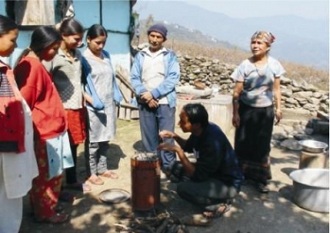Nonprofit chosen from among 107 proposals from 36 countries
Fort Collins-based Trees, Water & People has won a $1 million prize for sustainability from an international mining company, allowing it to expand two programs in Central America and Haiti.
“I am shocked,” Stuart Conway, Trees, Water & People co-founder, said in a telephone interview in Montreal, Canada, where he accepted the Rio Tinto Prize for Sustainability at the International Economic Forum of the Americas conference Tuesday.
“I know we do good work, but the competition was so tough I thought it would be hard to win. But it makes me feel good for sure,” Conway said.
Trees, Water & People was chosen for the Rio Tinto Prize for Sustainability from among 107 proposals from 36 countries, said Tony Shaffer, spokesman for Rio Tinto’s U.S. and South American interests.
The 11-year-old nonprofit plans to use the windfall – distributed over three years – to expand its community reforestation and cookstove programs in Honduras, Nicaragua and Haiti.
The cookstove program provides energy-efficient ventilated cook stoves that help reduce exposure to indoor cook smoke.
Respiratory problems caused by exposure to smoke from unventilated cooking fires kill more than 1.6 million women and children a year in developing countries, Conway said.
Trees, Water & People with local partners in Haiti, build stoves from clay, rice husks and molasses that sell for about $5.
An earlier model that sold for $10 was too expensive for about 60 percent of residents who live on about $1 a day, Conway said, leading the company to look for less-expensive ways to manufacture the stoves.
Part of the Rio Tinto prize money will be used to make more stoves and train Haitians to manufacture them throughout the country.
“It will help develop micro-entrepreneurs,” Conway said, “which makes it so much more sustainable in the long run.”
The stoves use up to 50 percent less wood and reduce the risk of respiratory disease caused by inhaling wood smoke.
As a result, they reduce the demand for firewood in parts of the world that are severely deforested and contribute to better health for women and children who are the most likely to be affected by indoor air pollution.
The reforestation program in Nicaragua plants thousands of trees and helps farmers establish tree nurseries to produce a sustainable supply of firewood, Conway said.
At current rates of deforestation, Trees, Water & People predicts Central America’s native forests could be gone by 2050.
By teaching rural Central Americans how to grow trees in self-sufficient nurseries, new trees are helping to replenish the forest, stabilize soil, protect water supplies and produce a sustainable supply of firewood. The nurseries also provide new sources of income for farmers and their families.
The award also saves Trees, Water & People from having to cut some international projects in the second half of the year, Conway said.
Trees, Water & People employs about 10 people at its offices at 633 Remington St. and another 30 who work for the company in Central America and Haiti, and had a budget of $1.55 million, according to its annual report.
“This was very timely, thank you very much,” Conway said. “Being a nonprofit, we are affected when individuals donate less, when foundations have less in endowments. This will allow us to maintain our programs and expand some.”
Proposals for the award are reviewed by an international panel of experts unaffiliated with Rio Tinto.
David Anderson, chairman of the prize adjudication panel and director of Guelph Institute for the Environment at the University of Guelph, Canada, said Trees, Water & People embodied the spirit of the prize.
“We are pleased that the work that Trees, Water & People is already doing with local communities on two continents to protect, conserve and manage the natural resources upon which their long-term well-being depends will now be boosted with the award of the Rio Tinto Prize for Sustainability,” he said in a statement.
Elaine Dorward-King, Rio Tinto’s global head of health, safety and environment, said in a statement the Rio Tinto Prize was designed to recognize nonprofit, civil and non-government organizations for significant contributions to the goals of economic, environmental and social sustainability.
Rio Tinto is an international mining group headquartered in the United Kingdom, combining Rio Tinto PLC, a publicly traded company, and Rio Tinto Limited, a public company listed on the Australian Securities Ex-change.
“Sustainable development is a critical part of our business model,” Shaffer said.
The award was part of Alcan, a company acquired by Rio Tinto in 2007.
Additional Facts
For information on Trees, Water & People, visit www.treeswaterpeople.org.
For information about TWP’s “Improved Cookstove Intervention to Assess Changes in Woodsmoke Exposures and Health Status among Nicaraguan Families” project, visit www.cvmbs.colo-state.edu/erhs/Nicaragua
Source – Coloradoan



